Understanding the prophecy of the last days being like the "Days of Noah" and the extreme spiritual opposition that lies ahead...are you ready?
And they overcame him by the Blood of the Lamb, and by the word of their testimony, and they loved not their lives unto death. (Rev. 12:11) Watch, and pray
Nov 21, 2014
The Arundel Boarded the Swift
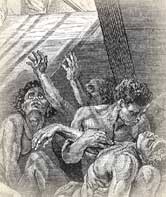
Sail, Ahoy!" On this day, November 20, 1759, the royal navy ship Arundel spotted unidentified sails. Captain Charles Middleton cleared the deck and ran out his guns. But rather than fight, the unidentified ship hove to and allowed herself to be boarded. She was the Swift of Bristol, a slaver. Soon Middleton asked his surgeon, James Ramsay, to go aboard. Ramsay would never forget the horrors he witnessed.
A foul stench met his nostrils as he stepped aboard. African men and women were packed like sardines into his hold. He could barely force himself to climb below where naked slaves wallowed in blood, feces and vomit, gasping for air. Plague had broken out. Ramsay did what he could to ease their suffering. Inwardly he vowed that he would do something to end the dreadful practice of slavery.
But what could he, a lowly surgeon do? As he reboarded the Arundel, he slipped and broke his thigh. This seemed to be God's way of moving him into a new capacity, for when his leg healed, he was so lame that he could no longer serve aboard ship. Every step he took on the rolling deck endangered his life.
Unknown to Ramsay, friends had arranged a lucrative partnership for him. He turned it down. He had in mind to fulfill a childhood dream and become a minister. After study and ordination in England, he sailed to St. Kitts in the West Indies to take up duties as a clergyman.
His congregation appreciated his medical skills but soon were on the outs with him because he opened the church to slaves and prayed for their conversion.
As a result of his "offenses," Dr. Ramsay endured of threats and humiliations. He was denounced in his own church. Enemies said that he was unfit to preach to whites; they should send him blacks. He replied that the souls of the poorest blacks were priceless and he would gladly preach to them. But, worn down by opposition, he finally admitted defeat after twenty years and retreated to England.
In the homeland, he found no personal peace. The shocking sights of the slave trade remained with him. He told friends he'd seen slaves whose hands were chopped off with axes when they were unfortunate enough to tangle them in the gears of sugar presses. Others were burned to death by angry masters. His friends pleaded with him to document these facts. Ramsay hesitated. He knew the planters would stop at nothing to close his mouth. Finally he agreed. Dipping his quill in ink, he produced an Essay on the Treatment and Conversion of Slaves in the British Sugar Colonies. Considered the opening salvo in the British campaign to abolish slavery, it was a best-seller from the moment of its publication.
As Ramsay expected, slave owners attacked him in press and Parliament. He had to defend himself against false charge after false charge. When he published An Address to the Publick, on the Proposed Bill for the Abolition of the Slave Trade pro-slavery forces made a new attack on his character in the House of Commons. Ramsay could bear it no longer. He sickened and died. An enemy gloated, "Ramsay is dead--I have killed him."
Bibliography:
- Morgan, Robert J. On This Day. Nelson, 1997.
- Pollock, John. Victims of the Long March and Other Stories. Word Books, 1970.
- "Ramsay, James." Dictionary of National Biography. Edited by Leslie Stephen and Sidney Lee. London: Oxford University Press, 1921 - 1996.
- Shyllon, F. O. James Ramsay: the unknown abolitionist. Edinburgh: Canongate, 1977.
Labels:
Christian History
Meet the Pathocrats, the richest .01%
Robert Reich
RobertReich.org
RobertReich.org
The richest Americans hold more of the nation's wealth than they have in almost a century. What do they spend it on? As you might expect, personal jets, giant yachts, works of art, and luxury penthouses. And also on politics. In fact, their political spending has been growing faster than their spending on anything else. It's been growing even faster than their wealth.
According to new research by Emmanuel Saez of the University of California at Berkeley and Gabriel Zucman of the London School of Economics, the richest one-hundredth of one percent of Americans now hold over 11 percent of the nation's total wealth. That's a higher share than the top .01 percent held in 1929, before the Great Crash.
We're talking about 16,000 people, each worth at least $110 million.
One way to get your mind around this is to compare their wealth to that of the average family. In 1978, the typical wealth holder in the top .01 percent was 220 times richer than the average American. By 2012, he or she was 1,120 times richer.
It's hard to spend this kind of money.
The uber rich are lining up for the new Aerion AS2 private jet, priced at $100 million, that seats eleven and includes a deluxe dining room and shower facilities, and will be able to cross the Atlantic in just four hours. And for duplexes high in the air. The one atop Manhattan's newest "needle" tower, the 90-story One57, just went for $90 million.
Why should we care?
Because this explosion of wealth at the top has been accompanied by an erosion of the wealth of the middle class and the poor. In the mid-1980s, the bottom 90 percent of Americans together held 36 percent of the nation's wealth. Now, they hold less than 23 percent.
Despite larger pensions and homes, the debts of the bottom 90 percent - mortgage, consumer credit, and student loan - have grown even faster. Some might think the bottom 90 percent should pull in their belts and stop living beyond their means. After all, capitalism is a tough sport. If those at the top are winning big while the bottom 90 percent is losing, too bad. That's the way the game is played.
But the top .01 percent have also been investing their money in politics. And these investments have been changing the game. In the 2012 election cycle (the last for which we have good data) donations from the top .01 accounted for over 40 percent of all campaign contributions, according to a study by Professors Adam Bonica, Nolan McCarty, Keith Poole, and Howard Rosenthal.
This is a huge increase from 1980, when the top .01 accounted for ten percent of total campaign contributions. In 2012, as you may recall, two largest donors were Sheldon and Miriam Adelson, who gave $56.8 million and $46.6 million, respectively. But the Adelsons were only the tip of an iceberg of contributions from the uber wealthy. Of the other members of the Forbes list of 400 richest Americans, fully 388 made political contributions. They accounted for forty of the 155 contributions of $1 million or more.
Of the 4,493 board members and CEOs of Fortune 500 corporations, more than four out of five contributed (many of the non-contributors were foreign nationals who were prohibited from giving). All this money has flowed to Democrats as well as Republicans.
In fact, Democrats have increasingly relied on it. In the 2012 election cycle, the top .01 percent's donations to Democrats were more than four times larger than all labor union donations to Democrats put together. The richest .01 percent haven't been donating out of the goodness of their hearts. They've donated out of goodness to their wallets.
According to new research by Emmanuel Saez of the University of California at Berkeley and Gabriel Zucman of the London School of Economics, the richest one-hundredth of one percent of Americans now hold over 11 percent of the nation's total wealth. That's a higher share than the top .01 percent held in 1929, before the Great Crash.
We're talking about 16,000 people, each worth at least $110 million.
One way to get your mind around this is to compare their wealth to that of the average family. In 1978, the typical wealth holder in the top .01 percent was 220 times richer than the average American. By 2012, he or she was 1,120 times richer.
It's hard to spend this kind of money.
The uber rich are lining up for the new Aerion AS2 private jet, priced at $100 million, that seats eleven and includes a deluxe dining room and shower facilities, and will be able to cross the Atlantic in just four hours. And for duplexes high in the air. The one atop Manhattan's newest "needle" tower, the 90-story One57, just went for $90 million.
Why should we care?
Because this explosion of wealth at the top has been accompanied by an erosion of the wealth of the middle class and the poor. In the mid-1980s, the bottom 90 percent of Americans together held 36 percent of the nation's wealth. Now, they hold less than 23 percent.
Despite larger pensions and homes, the debts of the bottom 90 percent - mortgage, consumer credit, and student loan - have grown even faster. Some might think the bottom 90 percent should pull in their belts and stop living beyond their means. After all, capitalism is a tough sport. If those at the top are winning big while the bottom 90 percent is losing, too bad. That's the way the game is played.
But the top .01 percent have also been investing their money in politics. And these investments have been changing the game. In the 2012 election cycle (the last for which we have good data) donations from the top .01 accounted for over 40 percent of all campaign contributions, according to a study by Professors Adam Bonica, Nolan McCarty, Keith Poole, and Howard Rosenthal.
This is a huge increase from 1980, when the top .01 accounted for ten percent of total campaign contributions. In 2012, as you may recall, two largest donors were Sheldon and Miriam Adelson, who gave $56.8 million and $46.6 million, respectively. But the Adelsons were only the tip of an iceberg of contributions from the uber wealthy. Of the other members of the Forbes list of 400 richest Americans, fully 388 made political contributions. They accounted for forty of the 155 contributions of $1 million or more.
Of the 4,493 board members and CEOs of Fortune 500 corporations, more than four out of five contributed (many of the non-contributors were foreign nationals who were prohibited from giving). All this money has flowed to Democrats as well as Republicans.
In fact, Democrats have increasingly relied on it. In the 2012 election cycle, the top .01 percent's donations to Democrats were more than four times larger than all labor union donations to Democrats put together. The richest .01 percent haven't been donating out of the goodness of their hearts. They've donated out of goodness to their wallets.
Read the rest of this article at - http://www.sott.net/article/289269-Meet-the-Pathocrats-the-richest-01
LA Marzulli - Nephilim | The Evidence
This is never before seen evidence of the Nephilim's interaction with planet Earth in the ancient past and in the present with alien abductions. LA Marzulli presents his new book, On the Trail of the Nephilim II. http://lamarzulli.net/ http://freemantv.com/
Labels:
Freeman,
LA Marzulli,
Nephilim
Enduring Legend of Popular Martyr King
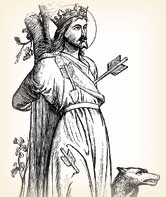
On this year the [Danes] rode across Mercia into East Anglia and took winter quarters in Thetford. And the same year King Edmund fought against them and the Danes had the victory; and they slew the King and overran the entire kingdom." That is all that the Anglo-Saxon Chronicle, written within twenty years of the events, had to say about King Edmund's death.
Danish invaders killed Edmund on this day, November 20, 869. Within thirty years, the common people had fixed him firmly in mind as a martyr and a saint. A special coin was minted for him. His burial site became a place of pilgrimage.
The Chronicle may have said little and Asser's famous Life of Alfred not much more, but popular accounts said a great deal. According to stories that were embellished as the years went on, Edmund was a godly English king--so godly that he even memorized David's Psalms to guide him in governing his people with justice.
When the Danes invaded in 866, Edmund struggled to hold his little state against them. He built a dike that held them back for a few years. But when he repulsed the Danish chiefs Hinguar and Hubba, they gathered a larger force against which he could not stand. The Danes insisted on terms of surrender that, as a Christian, Edmund could not accept. Realizing that his armies could not defeat the invaders and not wanting to be the cause of a pointless massacre of his own men, Edmund sent them home. While making his own escape, he was overtaken by Danes.
"Have you seen Edmund?" they asked. Not wishing to lie, Edmund responded with a riddle. His identity was soon recognized, however, and he was taken before the Danish chief Hinguar (also called "Ivar the Boneless" or Ingvar).
Again he refused to submit to pagan conditions. He said that his faith was dearer to him than life, and that he would never purchase his life by offending God. Infuriated, the Danes beat him with sticks, then tied him to a tree and tore his flesh with whips. Next they shot arrows into him until he looked like a "thistle covered with prickles."
The Danish leader finally whacked off the young king's head with an axe. Having been crowned king on Christmas day in 855 at fourteen or fifteen years of age, Edmund died while still in his mid twenties.
Supposedly the Danish leader flung the head into some brambles. Later, when the English crept out of hiding, they found a wolf protecting the head.
Bury St. Edmund, to which the king's body was eventually moved, became a major English religious center.
Bibliography:
- "Edmund the Martyr." http://www.pitt.edu/~eflst4/stedmund.html
- File notes from biographies on Alfred the Great.
- "King Edmund the Martyr." http://www.saint-edmunds.org/stedmundhistory.htm
- "Legend of St. Edmund." http://www.burystedmunds.freeserve.co.uk/ SurvivalKit/Motto.htm
- "Lives of Sts Edmund and Fremund." Canon of John Lydgate Project. http://www.ualberta.ca/~sreimer/edmund/intro/int3.htm
- Phillips, G. E. "St. Edmund the Martyr." Catholic Encyclopedia. New York: Robert Appleton, 1914.
- "Sacrarium Regis: Shrine of a King. The History of the Legend of St. Edmund." http://www.stedmundsbury.gov.uk/stedmund.htm
Labels:
Christian History
Nov 18, 2014
Will the Antichrist be an Assyrian?
A new but increasingly popular view is that the Antichrist will be an Assyrian. This conclusion is arrived at by a few passages in Isaiah, primarily Isaiah 10, and one passage in the book of Micah. I want to look closely at these passages as well as what the proponents of this view say about them to show you why I think this view is artificially contrived.
Labels:
Chris White,
prophecy
Lunar Wave (Hologram?) Confirmed By Two Additional Videos!
I have found this fascinating in connection with the "secret space program" and the videos have now been confirmed by multiple sources....so what's happening on the Moon?
The lunar wave is now confirmed beyond doubt for those who would explain it away as equipment failure. The two clips below show the lunar wave filmed by two separate people. This brings the count to four people who have filmed this event. Look at the clips and time stamps of each event.
James Hannon- time stamp of event: 3:13
https://www.youtube.com/watch?v=T_2sO...
Richard205maria- time stamp of event: 36 seconds
https://www.youtube.com/watch?v=l8GRQ...
Elon Musk on Artificial Intelligence: “We;re Summoning the Demon”
This is by far the most interesting story of the last two weeks. When someone with the knowledge and financing of Elon Musk makes a statement like this, I start looking around the corner for the Terminator....
by Joseph P. Farrell
Elon Musk is in the news again, though this time it’s not in reference to his space activities or new-fangled cars, but rather, in reference to his thoughts on the possibilities and implications of artificial intelligence. Consider this report from The Sydney Morning Herald (kindly shared by Mr. S.D.):
We are ‘summoning the demon’ with AI: technologist Elon Musk
Here’s the heart of it:
Read the rest of this article at - http://gizadeathstar.com/2014/11/elon-musk-artificial-intelligence-summoning-demon/
by Joseph P. Farrell
Elon Musk is in the news again, though this time it’s not in reference to his space activities or new-fangled cars, but rather, in reference to his thoughts on the possibilities and implications of artificial intelligence. Consider this report from The Sydney Morning Herald (kindly shared by Mr. S.D.):
We are ‘summoning the demon’ with AI: technologist Elon Musk
Here’s the heart of it:
“In an hour-long interview for MIT, which held its Centennial Symposium last week, Musk opened himself up to the audience for questions. Most of the questions were about space travel, but one audience member asked Musk for his thoughts on artificial intelligence, and that’s when things got a bit spooky.Despite the rather sneering tone of the Sydney Morning Herald in the last line quoted above, and the implicit materialist cosmology that it possibly disguises, Musk may have a point.
“‘I think we should be very careful about artificial intelligence,’ said Musk, the expression on his face suddenly turning very serious. ‘If I were to guess like what our biggest existential threat is, it’s probably that. So we need to be very careful with the artificial intelligence. There should be some regulatory oversight maybe at the national and international level, just to make sure that we don’t do something very foolish.’
“Sounds reasonable. Prudent even. A generally conservative approach to a potential technological issue facing our world in the future. Wise words.
“But then…
“‘With artificial intelligence we are summoning the demon,” said Musk. “In all those stories where there’s the guy with the pentagram and the holy water, it’s like, ‘Yeah, he’s sure he can control the demon.’ Doesn’t work out.’
“Forget Tony Stark, the comic book character most often associated with Musk, it may be time to start thinking Doctor Strange. Pentagram? Really, Elon?”
Read the rest of this article at - http://gizadeathstar.com/2014/11/elon-musk-artificial-intelligence-summoning-demon/
Spaceship Filmed Firing Thrusters In Front Of Moon
I have great interest in the "secret space program" which consumes billions if not trillions of dollars every year, and it seems more public revelations come every week. I took a brief sabbatical, but this was too fascinating to pass up...
This clip shows what I believe to be a spaceship under intelligent control, in orbit and firing its thrusters/engines in front of the moon - and beyond. I have never seen footage like this and it may be a one of a kind capture. It is a UFO by definition and clearly under intelligent control.
T-shirts: http://www.cafepress.com/crrow777
https://www.facebook.com/crrow.triple...
Clement's Date for Christ's Birth
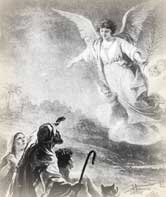
When was Jesus born in Bethlehem? The Bible tells us with certainty the fact of Jesus' birth and the place. But not the exact date. Although many Christians celebrate Christ's birthday on December 25th, it has not always been so. In fact, one of the early church fathers, Clement of Alexandria speculated that Christ was born on this day, November 17, 3 BC!
In the earliest church there seems to have been no celebration of Jesus' birth. Instead, each Sunday was a celebration of Christ's resurrection. The Jewish festivals of Passover and Pentecost continued to be celebrated by Jewish converts within the church for a time since they were closely associated with Christ's death and resurrection. In the third century, some churches in the east began to celebrate January 6 as the Epiphany, the time that Christ revealed himself to the people as the Messiah. Jesus' incarnation--when God became man--was also commemorated at this time.
Many speculated that since shepherds were in the field the night Christ was born, it must have been in spring or summer. Some said May 20; others fixed the date on April 19th or 20th. Still others thought March 25th most likely. No one really knew.
There is written evidence that by 354, the Bishop of Rome was observing December 25th as the date of Christ's birth. Four major Roman festivals were held in December, including Saturnalia which celebrated the returning Sun-god. Some thing these were adapted to the Christian celebration of the coming of the Son of God.
As Christianity expanded in Europe, the followers of Christ continued to celebrated December 25th as Christmas, and as each nationality converted to Christianity it brought its own customs to the celebration. But if Clement of Alexandria were still alive today he probably would be wishing us a "Merry Christmas" on this day.
"For the sake of each of us he laid down his life--worth no less than the universe. He demands of us in return our lives for the sake of each other."--Clement.
Bibliography:
- Adapted from an earlier Christian History Institute story.
- Bonsall, Elizabeth Hubbard. Famous Hymns with Stories and Pictures. Philadelphia: Union Press, 1923.
- Finnegan, Jack. Handbook of Biblical Chronology. Peabody, Massachusetts: Henrickson Publishers, 1998, 1964.
- Wells, Amos R. A Treasure of Hymns; Brief biographies of 120 leading hymn- writers and Their best hymns. Boston: W. A. Wilde company, 1945
Fritz Springmeier - Ebola Mind Control
Is Amanda Bynes crazy? We’ll look at the top ten signs of Monarch Mind Control and then dig into the Ebola crisis and its possible results. Is our fear of Ebola more deadly than the disease? Are there mind controlled victims unknowingly bringing the Apocalypse? Fritz Springmeier brings his encyclopedic knowledge to decode and dispel popular beliefs and even makes a prediction of what we might see with Katy Perry at the Superbowl Halftime Extravaganza! - See more at: http://freemantv.com/fritz-springmeie...
Labels:
Freeman,
Pestilence
Death of Charles Marshall, Quaker Mystic
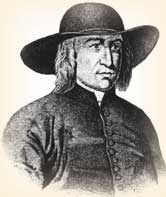
Charles Marshall labored for breath. Consumption (tuberculosis?) was killing him. He had recently returned to his home at Tytherton in Wiltshire, England and now was unable to go on with his ministry among Quakers. In fact, concerned friends soon moved him into John Padley's house near the river Thames. On this day, November 15, 1698, Charles Marshall died.
He was remembered as a man who diligently sought for God. In his journal, The Way of Life Revealed and the Way of Death Discovered, Charles wrote, "About the eleventh and twelfth years of my life, I not only longed to know the true and living God, but also sought after him..."
Charles was seventeen when he heard two Quakers, John Audland and John Camm, speak. They convinced him that George Fox (founder of the Quakers) had discovered the truth that Charles was seeking. Marshall joined the small but vigorous sect. Within a few years, he found himself in prison for his beliefs because Quakers rejected many of the forms and teachings of established churches.
A more gentle, loving and zealous Christian man could hardly be imagined: "a man of meekness and charity, a promoter of peace and healer of discords, whose practice agreed with his preaching. He gave medical treatment to the poor for nothing," wrote a biographer.*
Charles became acutely sensitive to the workings of God within his soul. He had his spiritual ups and downs, his times of doubt and coldness. But he also experienced a state of resignation and peace. "...I found, if at any time I went out from this pure, preserving power of God...and let in the spirit of the world and reasoned, and thereby beheld a beauty in any fruit but what was brought forth by the Tree of Life, then came over me a wound, a stain, a defilement."
In 1670 he felt commanded to leave his medical work for a time and preach. Leaving behind his wife and everything he owned, he traveled about England, speaking to four hundred meetings in two years. During this preaching tour, he was arrested, and dragged against some rails with such violence by the agents of the court that he was seriously injured. The court fined him for not attending the established church.
In 1682, Charles was thrown into the Fleet Street prison because he held Quaker views. He spent two years there. In spite of his preaching and his years in prison, he managed to keep his journal, write a book, and pen many letters. In one of these he sounded almost apostolic as he wrote [modernized]: "Dear Friends and brethren, that are suffering for your meeting together, in answer to the requirements of the Spirit of Jesus; my love in the fellowship of the sufferings of Christ salutes you, breathing to the God of the spirits of all flesh for you, that the grace that brings salvation, the mercy that comforts, the peace that is as a refreshing river, may be multiplied in you, and among you, to your satisfaction and rejoicing in the Lord."
When Charles died on this day, it was found that serving the Lord had not ruined him financially. In fact, he was fairly prosperous, leaving his family a medical practice at Bristol, estates in Pennsylvania, property at Tytherton and Bromhill and shares in a mine in Cumberland.
Bibliography:
- "Charles Marshall." Dictionary of National Biography. London: Smith, Elder and co., 1885-1901. *The quote is from this article.
- Fremantle, Anne. The Protestant Mystics. Boston: Little, Brown, 1964.
- Marshall, Charles. The Way of Life Revealed, and the Way of Death Discovered; [microform] London : printed by James Phillips, 1794.
- The Quaker Writings Home Page. http://www.qhpress.org/quakerpages/qwhp
Vitamin D Deficiency Linked to Neurological Diseases; Also Raises Risk of Asthma Attacks, and More...
By Dr. Mercola
If there ever was a Top Nutrient competition, vitamin D just might nab the title. It affects your DNA through vitamin D receptors (VDRs) that bind to specific locations on the human genome.
So far, scientists have identified nearly 3,000 genes that are influenced by vitamin D status, and a robust and growing body of research clearly shows that vitamin D is critical for optimal health and disease prevention.
This includes some of the more difficult-to-treat conditions, including Alzheimer’s disease,1 Parkinson’s, and multiple sclerosis2 (MS).
Vitamin D Deficiency Is Prevalent in MS
Multiple sclerosis (MS) is a chronic, neurodegenerative disease of the nerves in your brain and spinal column, caused through a demyelization process. It has long been considered a “hopeless” disease with few treatment options.The typical prescription for MS focuses on highly toxic medications like prednisone and interferon. However, research over the past few years suggests MS may be improved using a number of natural methods—including vitamin D.
Most recently, a study3, 4 presented at this year’s annual meeting of the American Association of Neuromuscular and Electrodiagnostic Medicine5 (AANEM) shows that vitamin D deficiency is surprisingly prevalent both among those diagnosed with MS, and patients suffering other neuromuscular conditions.Here, vitamin D deficiency was defined as a 25(OH)D3 level of 30ng/ml or less. Of patients diagnosed with a neuromuscular condition, 48 percent were deficient in vitamin D. Only 14 percent were above “normal,” which here constituted a vitamin D level of 40 ng/ml. According to one of the authors:
I believe optimizing your vitamin D level is of great importance if you have MS, but it’s not the only factor. For additional treatment suggestions, please see my previous article discussing natural MS treatment guidelines.“While the connection between vitamin D deficiency and neurologic disease is likely complex and not yet fully understood, this study may prompt physicians to consider checking vitamin D levels in their patients with neurologic conditions and supplementing when necessary.”Besides this one, about a dozen other studies6 have also noted a strong link between MS and vitamin D deficiency. For example, a number of studies have confirmed that your risk of MS increases the farther away you live from the equator, suggesting lack of sun exposure amplifies your risk.
Read more at - http://articles.mercola.com/sites/articles/archive/2014/11/17/vitamin-d-deficiency-asthma-multiple-sclerosis.aspx?e_cid=20141117Z1_DNL_art_1&utm_source=dnl&utm_medium=email&utm_content=art1&utm_campaign=20141117Z1&et_cid=DM60535&et_rid=731305630
Labels:
Dr. Mercola,
Healthy Stuff
Gregory Worked Wonders
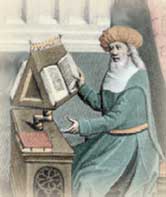
When Gregory became bishop of Neocaesarea in the region of Pontus (modern Turkey) in the year 239, there were only seventeen Christians. When he died (which tradition says happened on this day, November 17, 270), there were only seventeen pagans. That transformation was owing largely to his faithful efforts.
But before Gregory could lead people to Christ, he needed to know Him himself. Gregory was born into a prosperous pagan home and named Theodore (Gift of God). His parents expected him to become a lawyer. It was to fulfill that expectation that he and his brother planned to attend the famous law school at Beirut (in modern Lebanon). Their brother-in-law became an official in the government of Palestine, and before they headed off to law school, they escorted their sister to Caesarea so that she could rejoin her husband.
At that time, the famous Origen, a Christian theologian and scholar taught in Caesarea. Out of curiosity, the boys went to hear him. Immediately they were hooked. Origen's charm, his virtuous life, his sincerity, and tactical skill with arguments, his cleverly timed bursts of temper and sharp arguments persuaded them that Christianity was the truth. Both converted to the young faith. Law was forgotten for the next seven years as they immersed themselves in Christian theology and philosophy.
At some point Theodore changed his name to Gregory. Although devoted to Christ, he still planned to practice law when he returned home. All the same, Origen urged him to turn the reasoning of the Greeks to account for Christianity and Gregory did hope to write a definitive work proving Christianity the one true religion. He never accomplished this.
Instead, the few Christians of his hometown persuaded him to became their bishop. Neocaesarea was prosperous, idolatrous, and wicked. But with incurable optimism, Gregory exerted all of his talents in the task of converting pagans. To attract them within reach of the Christian message, he arranged games on martyrs' days. God granted him such gifts of healing that many people came to him to be cured and heard the gospel. If the legends are to be believed, he performed many astonishing miracles. There must be some truth in these, because he was known from the earliest times as Thaumaturgus, "Wonder Worker."
Gregory's one driving goal was evangelism which he saw as a joyful antidote to heathen despair. "And if any one does not believe that death is abolished, that Hades is trodden under foot, that its chains are broken, that the tyrant is bound, let him look on the martyrs deporting themselves in the presence of death, and taking up the jubilant strain of the victory of Christ. O the marvel! Since the hour when Christ despoiled Hades, men have danced in triumph over death. 'O death, were is thy sting! O grave, where is thy victory'?"
Bibliography:
- Butler, Alban. Lives of the Saints. Various editions.
- "Gregory Thaumaturgus." http://www.catholic-forum.com/saints/saintg40.htm
- Leclercq, H. "St. Gregory of Neocaesarea." The Catholic Encyclopedia. New York: Robert Appleton, Co. 1910.
- Slusser, Michael, translator. St. Gregory Thaumaturgus; life and works. The Fathers of the Church, Volume 98. Washington, D.C.: The Catholic University of America Press.
- "St. Gregory the Wonder worker." Greek Orthodox Archdiocese of Australia. http://home.it.net.au/~jgrapsas/pages/gregory.htm
- "St Gregory The Wonder Worker, Bishop Of Neocaesarea." John Mark Ministries. http://www.pastornet.net.au/jmm/afam/afam0079.htm
- UCLA Coptic Club. "Sayings from the Bible, Saints, and Church Fathers."
Celebrity Sacrifice Fappening
I think I should give a brief warning for those faint of heart or simply not wanting to know too many details about "fappening". So you were forewarned...
So many men are masturbating to their computers. Is there a demonic effect? Was the “Fappening” a form of ritual abuse?
http://freemantv.com/listen/the-free-...
Labels:
Freeman
Elizabeth Sang in Answer to a Bird

Elizabeth of Hungary was only 24 when she died on this day, November 17, 1231. She packed so much life and suffering into those 24 years that her story became the subject of art and legend.
Elizabeth von Thuringia was born in 1207, in a royal castle. Her mother Gertrude was a deep Christian who imparted faith to her daughter. Elizabeth's father, Andrew II, fought valiantly in the crusades, but was not a good king. His nobles forced him to sign Hungary's Magna Carta, the "Golden Bull."
Before she was two, Elizabeth was betrothed. At four she was sent to live with her prospective in-laws to learn their customs. Within the thick gray walls and iron gates of Wartburg, she grew to womanhood.
Gertrude was assassinated when Elizabeth was seven. The grieving girl knelt in the Wartburg chapel, praying for the souls of the murderers. Shortly after this, Elizabeth's fiancee died. Her status in Thuringia was cloudy. However, another son, Ludwig, said he would like to marry her.
When Elizabeth was just fourteen, her dream day came. In spite of family attempts to send her away as too holy, the beautiful girl married Ludwig. The two bound themselves to rule justly and to open their home in hospitality. Ludwig took as his motto "Piety, Chastity, Justice." Elizabeth adored him.
Elizabeth brought great wealth to the marriage. After her wedding, she had the choice of five castles to live in and so she was called "Elizabeth of many castles." But until she became pregnant, Elizabeth preferred to ride across the war-torn land with Ludwig.
A son was born to her. She carried him in her arms and walked barefoot to St. Katherine's chapel where she recited psalm 127: "Children are a heritage of the Lord, and the fruit of the womb is his reward."
St. Francis of Assisi had recently been called men to repent, cast aside the chains of wealth, and show kindness to the poor. Franciscans arrived in Thuringia in 1221. Elizabeth longed to share her blessings with the poor. Placing herself under the instruction of Brother Rodeger, she opened eastern Europe's first orphanage and tended lepers with her own hands. This outraged her hoity-toity in-laws. They tried to drive a wedge between Ludwig and her but failed. After he died, they seized her inheritance and expelled out.
She became a Franciscan tertiary, the first in the German empire and, after Ludwig's friends exerted their influence to restore her dowry to her, she opened a hospital and worked herself to death tending the sick. Overworked and undernourished, she succumbed to disease herself. As she lay dying, she was heard singing in response to a bird upon the wall. At cockcrow of her last day, she said, "It is now the time when [Christ] rose from the grave and broke the doors of hell, and He will release me."
Bibliography:
- Butler, Alban. Lives of the Saints. Westminster, Maryland: Christian Classics, 1981, 1956.
- Baring-Gould, S. Lives of the Saints. Edinburgh: John Grant, 1914. Source of the picture.
- New Schaff-Herzog Encyclopedia of Religious Knowledge. Grand Rapids: Baker Book House, 1954.
- "Elizabeth, St, of Hungary." The Oxford Dictionary of the Christian Church. Edited by F. L. Cross and E. A. Livingstone. Oxford, 1997.
- Various encyclopedia and internet articles.
Subscribe to:
Comments (Atom)

